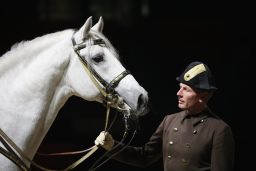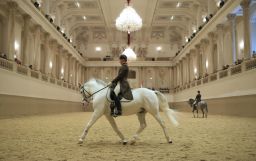Story highlights
Book launched on an equine Great Escape
Europe's finest horses rescued from the Nazis
Lives risked to stop horses being eaten
Firefight ensues in final days of the war
It has been described as “War Horse with a twist,” an equine version of “The Great Escape” in which opposing forces from the Second World War united to rescue some of Europe’s finest thoroughbreds.
A covert rescue operation in the dying days of war in Europe, it saved some 500 horses from the clutches of a starving, advancing Red Army whose soldiers, desperate for food, were slaughtering animals.
And it ensured the ongoing bloodline of many of the Lipizzaner horses that famously delight tourists at the Spanish Riding School of Vienna to this day.
Even US General George S. Patton, nicknamed “Old Blood and Guts” because of his passion for battle, showed a softer side to act as a key figure in how it played out.
The events over the final fortnight of the war read like a Hollywood script with American soldiers risking their lives simply for the love and safety of horses.
READ: Unseen photos of Europe after World War II
And it is a story that may yet hit the silver screen following the August publication of “The Perfect Horse” by American author Elizabeth Letts.
“General Patton effectively gave these soldiers permission to rescue these horses but, if it went wrong, they were dumb cavalrymen on their own,” Letts told CNN.
“They were crazy. Who in their right mind would do this? It didn’t make a huge amount of sense. It’s like ‘War Horse’ with a twist.
“They just wanted to get these horses, that’s how important they were to them. They valued horses pound for pound like fine art and risked men’s lives for this.”
Hitler’s breeding chief
Adolf Hitler’s chief of breeding Gustav Rau was given a base in the Czechoslovakian town of Hostau to gather Europe’s finest horses from the Lipizzaners through to Arabs and other top thoroughbreds with a view to creating the perfect military horse.
Rau’s inspiration originated at the 1912 Olympics where some of the world’s best military horses were lined up next to each other, giving him the idea, says Letts, to “develop a German breed of military horse that was as clearly associated with Germany as the thoroughbred was with England”.
But the Hostau base also happened to be a point where Patton’s Third Army, 35 miles away, was converging, with the Russians, some 60 miles to the east and the German forces determined to fight to the end despite it becoming apparent the war was reaching a conclusion.

READ: The East German racetrack that was a Cold War hit
The main protagonists of the story have all since passed away but their memories live on through their relatives.
Ulrich “Ric” Rudofsky, who now lives in the United States, can recall aged 10 regularly visiting the stables that his uncle Lieutenant Colonel Hubert Rudofsky managed.
“One of the expressions I remember was that he had to do something about the horses before the Russians ate them,” calls Rudofsky of his uncle, who was given an award in 1985, 40 years on from his equine efforts.
READ: Bring on the dancing horses
“He was never a member of the Nazi party and was never made a prisoner of war or anything like that. At the end of it all, he just took off his uniform and was with the horses. He was a real lover of horses. He was a hero to me, he was sort of my idol.”
German surrender
The German surrender in Europe was announced on May 7 1945 but some 11 days earlier, one of the final forays of the conflict began when a German intelligence officer, who had previously warned Rudofsky that the war was effectively over and to give up the stables, surrendered to America’s 2nd Cavalry Group with a myriad of photographs of thoroughbred horses.
The Cavalry Group’s leader, Colonel Charles Hancock ‘Hank’ Reed, contacted Patton, who told him regarding the horses: “Get them. Make it fast!”
Liaising with the lead vet at the stables, Captain Rudolf Lessing, a plan was hatched to rescue the horses.
Lessing told his senior officers: “It is our duty to do everything to save them. It is unimportant for us to win the war here at Hostau on April 27 or 28. This we should have done four years ago. To do it now is too late.”
But another German general had arrived at Hostau with troops determined to fight and Rudofsky could no longer guarantee the surrender he had initially promised.
Despite that, the following day, a peaceful surrender did at least transpire with Lieutenant William Donald “Quin” Quinlivan the first among 70 troops on the scene.
His daughter, Maureen Quinlivan Nolan, grew up with the stories of her father and describes the events thus: “He happened to be in the right place at the right time and was delegated to be the man on the scene with the troops.
“I know part of his concern was that the Russians would get the horses and not see their value for animal husbandry.”
With the base secure, the American troops assumed the mission was over but on April 30 a small German force determined to fight to the death engaged in a five-hour battle with the US soldiers in their new position.
Quinlivan Nolan says: “They had to encounter a firefight with some SS troops who were going to go down fighting. The war was over and they weren’t on a winning side. There were some pictures of some shelled or mortared vehicles so it was reasonably serious.”
READ: High-end horses: Meet the equestrian jet setters
It ended with two American troops losing their lives and was their last encounter of the war.
A few days after the overall German surrender, Colonel Alois Podhajsky, who had ridden at the 1936 Olympics and was head of the Spanish Riding School of Vienna, was reunited with his horses. The thoroughbreds had since been moved to Germany at the behest of Patton, to whom he had displayed the many liberated Lipizzaners just days before.
‘The story lives on’
A total of 244 of those famous horses were then driven back to Austria, while other Arabs and assorted thoroughbreds made their way back to the United States.
READ: Adolf Hitler and the man ‘who beat Jesse Owens’
One group of 30 horses was overseen by Quinlivan, with British troops warning that equine lives would be lost on the crossing. Instead, recalls his daughter, “they arrived in the US with 31 horses with one having been born along the way.”

Among that group was Polish stallion Witez II, who sired 223 foals in the United States including 16 national show champions.
For Letts, it was a story she stumbled across by mistake during research for her first novel, the Eighty Dollar Champion.
“I found a pamphlet about horses in the US seized by the American army in Czechoslovakia at the end of the war and a parade of them,” she says. “I didn’t really know what I was getting myself into and four years later there’s a book.”
Her children dubbed the project “Saving Private Horse” – a nod to the 1998 film with Tom Hanks and Matt Damon – during the lengthy and often painstaking project for the midwife-turned-author.
It became a personal labor of love for Letts, a budding rider in her younger days, while the rescue had major repercussions for the equine bloodline in Europe and the United States.
“Without this rescue, the bloodline of the Lipizzaners might have been lost and there’s a lot of horses in the United States today that trace back to the bloodline of the horses brought back here. So the story lives on.”













